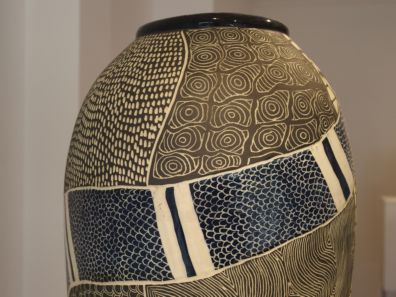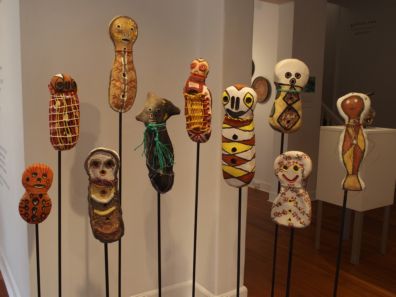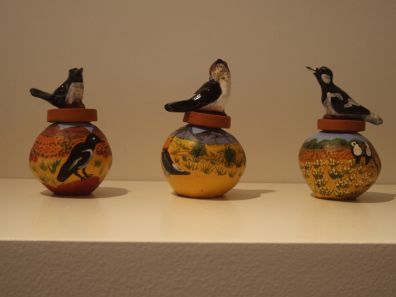INDIGENOUS STORIES IN CLAY

The Derek Tjungarrayi Thompson pot, 'Wanampi' touring in the exhibition of Aboriginal pottery called 'Clay Stories'
Posted by Jeremy Eccles | 14.03.17
Dates:
10.03.17
: 08.04.17
Location: Sabbia Gallery, 120 Glenmore Road, Paddington, Sydney
When a gallery that specialises in three dimensional art – whether in glass or clay – puts its mind to the Indigenous realm, then the result is likely to be pretty comprehensive. Anna Grigson from Sydney's Sabbia Gallery used to work at Quadrivium in the Queen Victoria Building, which surprised occasionally with Utopia artworks from the Fred Torres stable of artists. Today, in arty Paddington, she's kept clear of canvases and has established Sabbia as the foremost venue for art-glasswork and ceramic creations of all sorts.
Now it's working with the Remote Communities Ceramic Network (the RCCN) to bring together works from five communities – Ernabella, Erub Arts, Girringun, Hermannsburg and the Tiwi Islands. Missing, sadly, is Queensland's Yarrabah where the exciting Michelle Yeatman lays claim to the mantle of the great Thancoupie, Aboriginal Australia's most significant potter. But, as this exhibition picks up its skirts and tours from later this year into 2019, there's no reason why other artists and other works from places like the prolific Tiwi Design Potters studio – who only have one artist, Jock Puautjimi represented in the Sydney show with works that show their origin in the Islands' abstract ochre paintings – will not be added. Tiwi Design is just bedding in a brand new studio, which may have been a distraction.
But, as QAG curator, Bruce McClean tells us in the catalogue, the Tiwi were really the progenitors of Aboriginal potting. In 1968, the UNSW and NT Government Welfare Board brought the significant English post-Leachian potter Michael Cardew out to start the Bagot Pottery off in Darwin. Its early trainees weren't Larrakia but significant names such as Bede Tungutalum, Eddie Puruntatameri and Ronald Kerinaiua from Tiwi – to which they later returned to start the Tiwi Pottery on Bathurst Island. Sadly, Bagot was destroyed in 1974 Cyclone Tracy and never restarted. Tiwi continues.
Also in the Sabbia catalogue is the claim that the RCCN is in need of “reinvigoration”. It was established in 2009 with three centres – Tiwi Design, Ernabella and Hermannsburg – participating in collaborative workshops, mainly in Canberra. Not much seems to have happened since 2011 even as individual art centres have become more active.
Perhaps the most popular work is from the Ntaria ladies in Hermannsburg who seem to have frequent exhibitions of their characteristic pots – rounded and painted with Namatjira-style watercolour scenes, then surmounted by stoppers with modelled clay creatures. Adventure doesn't seem to extend much beyond swapping landscape and cockatoos for much-admired footy players. An intriguing set of miniature pots by Rona Panangka Rubuntja – 'Ntaria Birds' – is a bit of breakthrough.
Undoubtedly, the most accomplished artist on show is Derek Jungarrayi Thompson from Ernabella, our oldest Aboriginal art centre, but only potting since 1998. Thompson has been seen before at Sabbia and his progress has been significant. While the ceramic work itself remains unadventurous, his decoration of it has gone up notches in design and sophistication – undoubtedly appealing to the non-Indigenous art collector of ceramics. The way he can now weave the traditional story line involving a mythic Rainbow Serpent figure into field of desert dots and lines and other repeated motifs in a work like 'Wanampi' is a delight. His most recent work, 'Wati Ngintaka' tells of the Perentie Lizard who stole a grinding stone he'd heard on the wind 800 kms away and knew to be superior to any in his own community.
Most intriguing, I suspect both in Sydney and as 'Clay Stories' travels will be the ceramic figurines from Girringun. These Bagu figures sprang upon the world at the first Cairns Indigenous Art Fair and have made their mark to the point that last year's big Indigenous exhibition of works related to the sea in Monaco's Maritime Museum featured them prominently. I've never known quite what to make of them, but the catalogue does its best to explain that these simple, hollow-eyed human figures are ancestral spirits, bringers of fire to the damp rainforests of Far North Queensland via shooting stars. So you get a human figure and accompanying firesticks – formerly made from specific woods, the milky pine and the wild guava. Now they've discovered the saleability of traditional clays decorated with ochre colours such as magera yellow, jillan, garba white, black and just a few drops of wallaby blood. Nine different Traditional Owner groups operate at Girringun, so variety in the Bagu is the name of the game.
Does the same person buy something so specifically Indigenous – a Bagu figure or a Jimmy Kenny Thaiday ceramic dance mask from Erub Island in the Torres Strait – as buys a Derek Thompson pot that can blend in with a blue and white ceramic collection from China? Both classes exist, says Anna Grigson, Sabbia's Director. “There are undoubtedly Aboriginal art collectors who see specifically Indigenous works as a relevant addition to their collection. And there are ceramic collectors who see 'works from the earth' as a valid part of their collections. Because of our speciality, they've been the first in through the doors for this show”.
Interestingly, objects like the ceramic Bagu seem to have been the only sort of pottery that, historically, Aboriginal communities produced and used in ceremony. Afterwards, they would be destroyed. It raises the question as to why, with supplies of clay and the use of fire, Aboriginal society saw no use for pottery to transport water or store food. Pretty much every other ancient society did make pots, and the Macassans certainly brought them to the north hundreds of years ago without causing significant change. I've seen clay pots in Papua New Guinea simply placed in a fire to harden, so no sophisticated oven is needed. But they were in communities that are perhaps more settled than many Aboriginal groups.
A mystery. Any theories?
By the time 'Clay Stories' reaches Coffs Harbour's Regional Gallery in May 2019, quite a lot of people will have had the opportunity to consider the matter – though they'll need to keep in touch with the dedicated website - www.claystories.com.au - to find out precisely where the pots are coming to rest apart from the Jam Factory offshoot in the Barossa at Seppeltsfield in October this year, and the Craft Centre in Canberra in May 2018.
URL: http://sabbiagallery.com/exhibition/clay-stories/
Share this:
»  del.icio.us
»
del.icio.us
»  Digg it
»
Digg it
»  reddit
»
reddit
»  Google
»
Google
»  StumbleUpon
»
StumbleUpon
»  Technorati
»
Technorati
»  Facebook
Facebook
Contact Details

A field of Bagu from Girringun in tropical forests of North Queensland

Three of the seven miniature 'Ntaria Birds' by Rona Panangka Rubuntja from Hermannsburg
Further Research
Artists: Bede Tungutalum | Derek Jungarrayi Thompson | Eddie Puruntatameri | Jimmy Kenny Thaiday | Jock Puautjimi | Michelle Yeatman,Thancoupie | Rona Panangka Rubuntja | Ronald Kerinaiua
News Tags: Anna Grigson | Bagu | Clay Stories | Indigenous pottery | Jeremy Eccles | Remote Communities Ceramic Network | Sabbia Gallery
News Categories: Australia | Blog | Exhibition | Feature | Industry | News
Exhibition Archive
- 16.03.18 | SPECIAL REQUEST
- 20.02.18 | Gapu-Monuk – Saltwater Barks
- 16.02.18 | SONGLINES SYMPOSIUM
- 06.02.18 | SONGLINES – TRACKING THE SEVEN SISTERS
- 31.01.18 | Dennis Nona Emerges in Hobart
- 30.11.17 | Great Artists, Great Stories, Limited Time
- 27.11.17 | Moodoonuthi - 'Little One'
- 24.11.17 | 20% Off until End November
- 23.11.17 | THE APY LANDS COME TO SYDNEY
- 14.11.17 | Entries Open for 2018 NATSIAAs
- 01.11.17 | PAINTING COUNTRY
- 23.10.17 | The Scholls Donate Half their Art
- 10.10.17 | TARNANTHI 2017
- 11.08.17 | Natsiaas 2017
- 20.07.17 | APY ART DOMINATES THE WYNNE
Advertising

